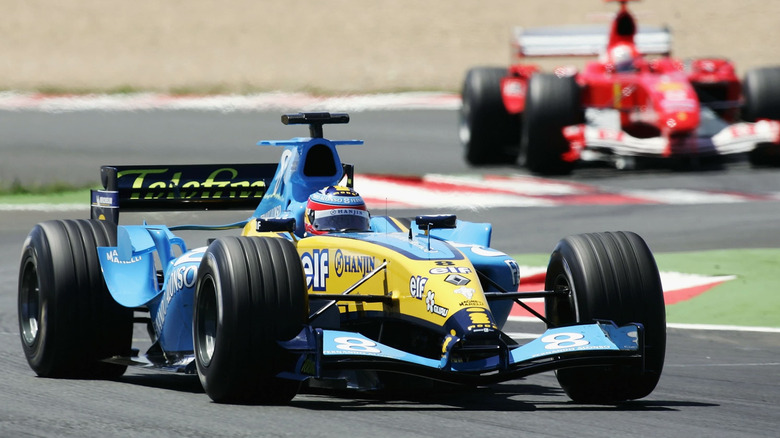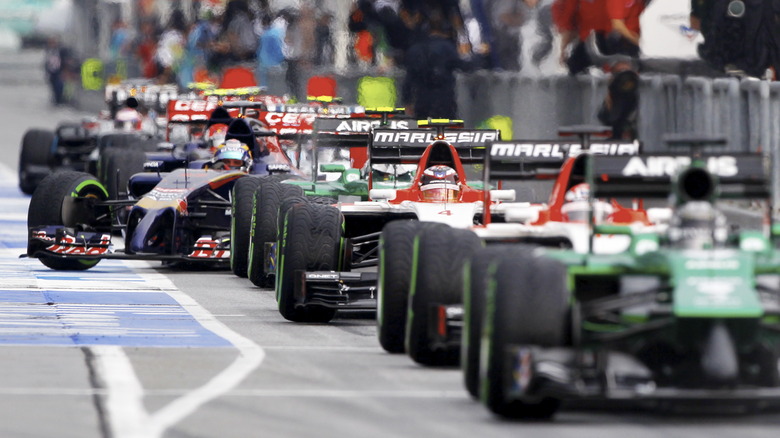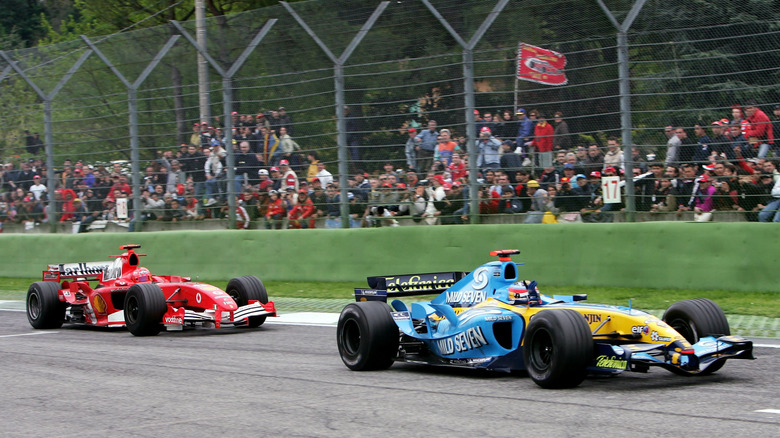Why Did F1 Stop Using V-10 Engines? (And Why Some People Want To Bring Them Back)
If you watched Formula 1 racing in the late 1990s to 2000s, chances are you vividly remember the howling roar of the V-10 engines (and some of the incredibly fast F1 cars they powered). These sounds defined F1 for a generation, with many categorizing it as the sport's "golden era." But we witnessed the demise of these motorsport icons in 2006, when the last remaining V-10 was pulled. And the iconic naturally aspirated sound died in 2014 with the introduction of the V-6 hybrid powertrain, bringing with it the ongoing "Hybrid Era."
Formula 1 initiated this era in the name of technological advancement and promoting fuel efficiency, continuing to this day with the new 2026 F1 engine regulations. There have been petitions to resurrect the classic V-10 over the years, but nothing ever gained significant traction. Even a new internal proposal to bring them back didn't do well. Four of the five current engine manufacturers would have had to agree for it to be adopted, and since the new 2026 engine regulations were right around the corner, they had already committed substantial resources to the project — money and time that would go to waste should a new powertrain suddenly be announced.
So while fans (and apparently many higher-ups) would welcome these engines back with open arms, the timing now is truly horrible. With so much capital investment on the line, there's little chance of these engines coming back, at least in the 2020s.
Ending the golden era
People often cite the V-10 as the greatest F1 engine of all time, and with good reason. The sound alone proved incredibly attractive, so much so that even today many fans and officials long for those glory days of the screaming V-10s and the V-8s that came after. Even the F1 founder Bernie Ecclestone prolifically criticized the move to the hybrid V-6 engines F1 uses today. Orher big names in F1 and motorsports journalism referred to the change as a mistake and a failure.
But the move wasn't without its defenders, and in the end, the technology developed from these engines unquestionably pushed much of the hybrid power-train progress we see in road cars today. That's because, as a system, a hybrid V-6 requires vastly more resources to make work well than a V-10. You have not just the engine, but the turbocharger system, hybrid power train, its associated electronics, and shrinking all of that down to fit into an ultralight F1 car. So despite the added expense, mechanical complexity, and associated development time, hybrid engine development advanced hugely within the past decade, both off and on the circuit.
That leads us to today, when people still insist that you can have your V-10 cake and eat it, too. Do they have a point? Let's discuss some of the criticisms of the current era and what can practically be done to accommodate F1's ultimate goals of technological advancement in alternative energy and fuel efficiency.
Not (just) about sound
A single Formula 1 car uses about 110 kilograms of fuel per race. With 20 cars per race and 24 Grands Prix for the 2025 season, that means roughly 52,800 kilograms of fuel, or about 18,600 gallons of 0.75 g/mL-density gasoline, used per season — quite a lot, right? Well, a 2019 survey tells us that, statistically speaking, the fuel actually used by the hybrid V-6s accounts for just 0.7% of the total sum, with the vast majority going to logistics and transportation. That said, this only represents the emissions F1 produces in terms of percentages and ratios, misrepresenting the overall impact hybrid technology had in the automotive industry.
With Formula 1 and other motorsports divisions on the bleeding edge of fuel-efficient speed, many feel there's simply no place for a V-10, but some critics say that's not the case. After all, what's stopping F1 from running these engines on sustainable fuel, or limiting their fuel usage in less-public circles such as their seaborne and airborne logistics, research-and-development consumption, and other areas? Considering the relatively miniscule impact of an F1 car's engine on the environment, certainly when compared to the impact of shipping the cars to the track, what would a V-10 matter?
But it matters a lot, and not just because these engines may seem outdated. Teams have poured vast resources into developing power plants for the upcoming regulations changes, and simply can't turn back now. What happens afterward, we can only speculate and hope.


